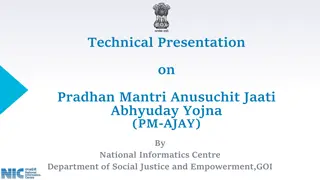Understanding Management Information Systems (MIS)
Management Information Systems (MIS) are vital for collecting, processing, and analyzing data in business activities. They assist decision makers, facilitate communication, and maintain records. Components include people, data, business procedures, hardware, and software. Various types of information systems serve different organizational levels, such as Transaction Processing Systems (TPS) for daily transactions, MIS for tactical decisions, and Decision Support Systems (DSS) for top-level decision-making. MIS offer advantages like information storage and protection but also come with some disadvantages.
Download Presentation

Please find below an Image/Link to download the presentation.
The content on the website is provided AS IS for your information and personal use only. It may not be sold, licensed, or shared on other websites without obtaining consent from the author. Download presentation by click this link. If you encounter any issues during the download, it is possible that the publisher has removed the file from their server.
E N D
Presentation Transcript
What is management information system? Management information systems (MIS) are systems used to collect, store, process and analyze data from various business activities. Example of MIS include customer relationship management systems (CRM),enterprise resource planning systems (ERP),and data warehouse system.
The needs for management information system Decision makers need information to make effective decision Management information system make this possible. Management information system facilitate communication within and outside the organization employees within the organization are able to easily access the required information for the day to day operation. Record keeping- Management information system record all business transaction of an organization and provide a reference point for the transactions
Components of management information system The major components of a typical MIS long-form management information system are: People- people who use the information system. Data- the data that the information system records. Business procedures- procedures put in place on how to record , store and analyze data. Hardware these include servers, workstations , networking equipment ,printers , etc. Software- these are programs used to handle the data. These include programs such as spreadsheet programs, database software, etc.
Types of information system The types of information system that a user uses depends on their in an organization. The following digram shows the three major levels of user in an an oraganization and the type of information system that they use.
Transaction processing system (TPS) This type of information system is used to record the day to day Transactions of a business . An example of a transactions of processing system is a point scale (POS) system .A POS system is used to record the daily scales. Management information system (MIS) Management information systems abbreviated as MIS, are used to guide tactic managers to make semi- structured decision . The output form the transaction processing system is used as input to the MIS system. Decision support system(DSS) Decision support systems are used by top level managers to make semi-structured decisions . The output from the management information system is used as input to the decision support system. DSS system also get data input form external sources such as current market forces, competition, etc.
Advantages and Dis-advantage of information system Advantages of information system Storage and protection of information The storing components of information system are created to collect and store an enormous amount of data . These stored data can be accessed by the users whenever necessary. Maintaining the security of company records is very vital to the integrity of the company . Moreover, hackers can be blocked with intense security . Even the virtual vault limits the loss or damage of electronic information during a system breakdown. More efficiency and greater productivity Most businesses are now highly dependent on information system for more efficiency and increased productivity. The automated processes enable the completion of more work in shorter amount of time . This allows the employees to handle a greater workload with more efficiency and accuracy and less human error . Many task are completed by the computer . This provides more free time and flexibility to the employees to focus on other tasks to improve the company s efficiency as well.
Reduced risk of errors As information systems employ automated processes so users can get the most accurate information needed to perform an activity . It is better to say that all the steps- from input to organizing , storing , and processing of data and finally output- are done with great accuracy. Better communication Communication is very essential to personal as well as business relationships . the success of a company depends highly on communication between supervisors and employees ,as well as between employees and clients . Telecommunication in the form of video conferences , email , fax , and so on allow easier exchanges of information and opinions.
Disadvantages of information system Expensive At the primary level , some technologies ,hardware ,tools , and means of communication require great expenses. Then the setup of the information system can also be very costly. Regular maintenance and repair of these types of equipment are also required .Updating and upgrading the devices, software , and other components associated with additional costs. Apart from the technological side , people should also be employed to operate the system and thus should be paid wages .Training of these people again requires some expenses.
Reduction in job As tasks are completed quickly and efficiently using an information system so employees get more time . So , to operate fully companies are trying to combine jobs in order to reduce the number of employees. In some cases, machines are replacing human labor and eliminating jobs . Security breaches Electronic information is highly prone to security breaches. Hackers are constantly updating and upgrading themselves along with the technology . So ,companies should keep security specialist employed all the time to prevent any threat to security of their vital information . This interrupts the smooth functioning of the system ,causing customer dissatisfaction and other problems for the company.























